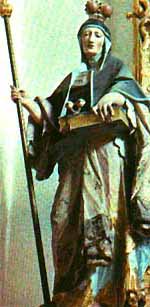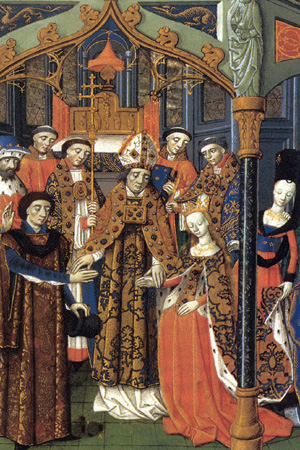 |
The Saint of the Day
St. Cunegundes - I - March 3
Prof. Plinio Corrêa de Oliveira
Biographical selection:
St. Cunegundes, virgin, was Empress of the Holy Roman Empire. She and her husband, St. Henry II guarded perpetual virginity in their marriage.

Empress St. Cunegundes, wife of St. Henry II
|
Together the couple carried out many pious works and practiced prayer and mortification. After his death in 1024, she went to the Convent of Kaufungen (Hesse), which she had founded. She died there in 1040 and was canonized by Pope Innocent III in 1200.
Comments of Prof. Plinio:
A certain egalitarian mentality saturated with sentimentalism that has strongly influenced contemporary piety leads us to think that everyone who lives in the higher stratum of society, surrounded by luxury and pomp, is infallibly a worldly person. According to this mentality, it is not possible to be a saint and at the same time enjoy these good things of earthly existence. A person with this mentality thinks that to be a saint, one has to live in a mediocre house and ambience in order to avoid worldly temptations. Following this line of thinking, the glory of an Emperor or an Empress would not be compatible with sanctity.
On the contrary, here we have St. Henry and St. Cunegundes, who were both saints and were at the very top of the social-political hierarchy.
Let me imagine the day of the coronation of an Emperor. After the Emperor is elected by the seven Elector-Princes, he goes to the balcony of the Romer in Frankfurt wearing a gold and silver embroidered mantle and with the imperial crown on his head. He greets the assembled people, who applaud and cheer him. From a sack, he takes handfuls of golden coins and throws them out to the people, who strive to catch them.

The Romer, or Imperial Hall, in Frankfurt where the Emperors were elected
|
A small bell in the tower of the Romer begins to peal, followed by the great bells in the churches of Frankfurt, and then in the churches throughout Germany and Christendom, all trailing that first small bell and all tolling to announce the election of the new Emperor. Wine, instead of water, starts to flow from the fountains of the city; the people sing and dance. In the churches Te Deums are sung.
The Emperor descends, mounts his horse and begins to ride through the streets of Frankfurt to greet and be greeted by people assembled there and in the balconies of the houses. A noble holds the reins of his horse, followed by yet other nobles in ceremonious cortege. The better houses display their richest tapestries from their balconies and windows to honor the Emperor. He returns in triumph and a splendid feast is prepared. His table is several steps above the others, and a noble, not a servant, comes to serve his meal. I could continue this description, but let me stop here.
Let each one of us imagine himself in the place of the Emperor. It is evident that we would have a serious temptation toward pride. If it is a temptation for us, why wouldn’t it also be a temptation for St. Henry and St. Cunegundes at their time?
The answer is simple. St. Cunegundes and St. Henry were accustomed to that life. They were born into royal families at a time when princes were wealthy and normally held great power. Power and pomp were co-natural to them. They were related to the whole court of the Empire as well as many courts of other kingdoms. For members of such families to become Emperor and Empress, therefore, did not mean a complete change of lifestyle. It was certainly a great honor, but they maintained essentially the same level of life as they had before.

Contrary to modern assumptions, sanctity can flourish in courtly ambiences
|
What causes a person to be tempted toward pride is when he jumps quickly from one level to another much higher than his normal state of life. Since St. Cunegundes had always lived in a court ambiance - she was daughter of Siegfried, sovereign of Luxembourg - it was not an occasion of sin for her to become the Empress.
The conclusion, therefore, is not that the higher positions and titles should be abolished to avoid the temptation of pride, but rather that such positions should be proportional to the individuals and the ambiences in which they were born, just as the size of the seed is proportional to the beak of the bird. This is the correct principle that should be applied to avoid pride.
No one has vertigo if he climbs two or three steps above the level to which he is accustomed. What gives a person vertigo – the temptation of pride – is to jump to a disproportionately high new position. Therefore, in a society that is hierarchically constituted, normally the highest positions of power would be held by persons from the highest classes.
Of course, there are exceptions. If you have a man of great capacity who is not a member of these families, he would deserve a higher position, or perhaps the highest position, since it is proportional to him.
With St. Henry and St. Cunegundes, then, you have the example of persons from the highest social stratum who lived amid the pomp and circumstance of a courtly ambience and were perfectly humble and unpretentious.

More on St. Cunegundes

  |
|
Prof. Plinio Corrêa de Oliveira | |
The Saint of the Day features highlights from the lives of saints based on comments made by the late Prof. Plinio Corrêa de Oliveira. Following the example of St. John Bosco who used to make similar talks for the boys of his College, each evening it was Prof. Plinio’s custom to make a short commentary on the lives of the next day’s saint in a meeting for youth in order to encourage them in the practice of virtue and love for the Catholic Church. TIA thought that its readers could profit from these valuable commentaries.
The texts of both the biographical data and the comments come from personal notes taken by Atila S. Guimarães from 1964 to 1995. Given the fact that the source is a personal notebook, it is possible that at times the biographic notes transcribed here will not rigorously follow the original text read by Prof. Plinio. The commentaries have also been adapted and translated for TIA’s site.

|
Saint of the Day | Home | Books | CDs | Search | Contact Us | Donate

© 2002- Tradition in Action, Inc. All Rights Reserved
|
 |
|